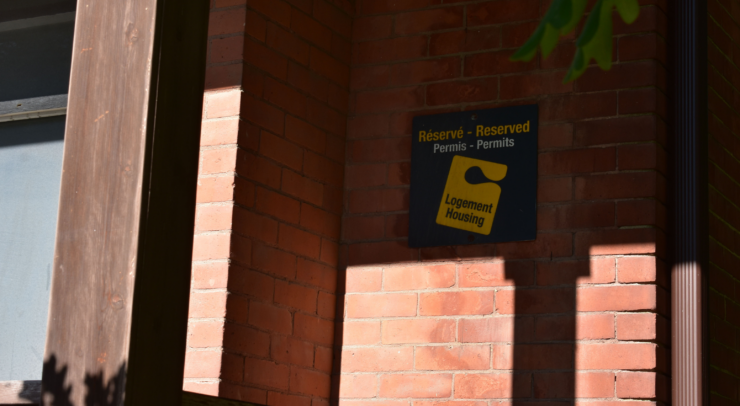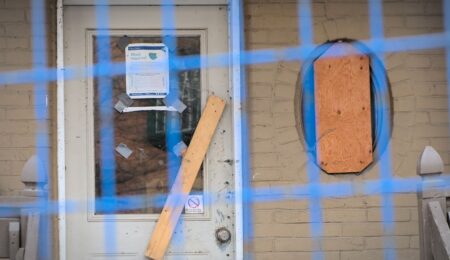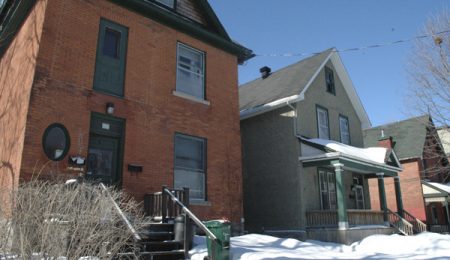What is the future of housing for students at the U of O?
Over the past few years, the landscape of housing in Canada has changed drastically and the effects of this issue is not isolated — the student housing market is a mirror of the larger Canadian housing crisis with a reported availability for only 10.3 per cent of registered students. This scarcity impacts all types of students, albeit at varying degrees.
At the U of O, students typically choose one of three options: live with family, live in residence, or rent a place off-campus. While each group of students is deeply affected by the current housing market, those living in student residences and in apartments off-campus have been bearing the brunt of the situation.
The Nightmares before Moving
Currently the university offers leases ranging from $8,417 for an eight-month lease to $22,502 for a twelve-month lease. Price differences are impacted by how prime the location is and the offered amenities such as private rooms and on-site resources; making residences like 90U and 45 Mann popular amongst students.
Eberechi Ahiakwo is a third-year social sciences interdisciplinary studies student living at 45 Mann. They commented, “Being an international student, I don’t have to worry about the length of my contract. It is convenient and the distance is nice too. However, I wouldn’t mind paying less for where I live.”
However, residence prices are not convenient for all students and only a limited number of people can live in the prime residences at any time.
Rachael Neff, a first-year mechanical engineering student living in 90U, said that while she was happy with her residence experience, it came at a cost.
“My experience living in 90U was pretty good. It’s close to campus and I liked the room situation. I don’t plan on coming back, though. I found some people to room with next year because it is really expensive [to live in residence]. I think moving out will be cheaper in the long run.”
Students who live in traditional residences often move to off-campus housing after their first year in residence.
“I lived in residence [Friel] in my first-year but moved out, partially because it was expensive, but mostly because I wanted my own space.” said Kristina Abbarin, a third-year joint history and political science student.
“It was frustrating finding an apartment. There are some really terrible places and they just raise the prices, because they know that students need places to live. Not many places offer eight-month leases, and not all students are going to stay in Ottawa for [12 months]. That kind of pigeon-holed my friend and I into choosing where we live now. It’s not bad, but it’s not the best.”
What is the university doing?
In order to see what the university was doing to combat this problem, the Fulcrum spoke to Geoffrey Frigon, associate vice-president of facilities, who has been active in the university’s resident development plan project for around four years.
According to Frigon, building a residence requires detailed plans to ensure that the residence is successful on campus. To meet the demands of students surveys, market research, comprehensive demand analysis, and more are utilized throughout the planning. The entire process of building the residence can take between two to four years.
Currently, the university has many land holdings around King Edward Avenue that stand unoccupied. These holdings were initially purchased to meet the academic and student housing needs of students and staff at the time of their purchase. Frigon mentioned in an email to the Fulcrum, “We are currently evaluating options to determine the most effective use of our land holdings.”
While converting these buildings and some other currently unusable buildings around campus into residences is a quicker option, taking two to three years, Frigon clarified that “Life-cycle costing and business cases have determined that it’s not cost-effective to re-purpose the buildings.”
In the meantime, the University of Ottawa administrators have been working on improving current campus housing over the past few years. Patrick Genest, senior director of client relations for students affairs, is responsible for managing 15 U of O residence buildings, both on and off-campus. He sat down with the Fulcrum to discuss the institution’s involvement in student housing.
Genest highlighted that during the 2024 fall residence move-in, “administrative efforts [had cut down] 80-90 per cent of complaints, leading to a satisfaction rate of 80-83 per cent” among U of O students in residence. “These ratings are produced despite challenges,” Genest said, noting the September engineer strike in particular, which threatened hot water availability to students living in residence and disrupted traffic during move-in days.
Despite the positive reviews, Genest acknowledged that some students were “waitlisted [from their first choice of residence], only to be unhappy with what the university could offer them”. As first-pick residences like 90U were filled up within 12 hours of the registration opening, older buildings such as Leblanc, Thompson, and Stanton still had occupancy but are “not necessarily what students are looking for.”
To better optimize occupancy rate, future U of O housing plans — including the replacement of the former Brooks residence, which closed in 2018 due to mould — are highly influenced by student input, through the consideration of a 2021 data report produced by a third-party consultation group. According to Genest, data from this report suggested that the top three most important aspects are affordability, proximity to campus, and accessibility to wireless internet.
In an emailed statement to the Fulcrum, the university said that it is committed to providing cost-effective and inviting residences in consideration of the current student housing market. It is currently working to include more upper-year student beds into its existing inventory and is running a public process that will potentially build an additional 2,600 beds on campus for first and upper-year students.
Stinky, stinky residence life
In recent years, the university has faced harsh criticism over living conditions offered to residents in older dorms. Since 2014, student testimonies of life on campus led to local media coverage and warnings among students to avoid leasing certain residences.
The Brooks residence, built in 1987, came with a price tag of $23 million dollars and quoted the ability to house 700 students for 60 years — however, it was only utilized for half of its projected lifespan. Suspected flaws in the building’s construction, led to reported mould growth in the dorm. Despite sitting vacant for seven years, a 2023 CBC investigation found that the structure was costing the university multiple thousands of dollars in monthly utility bills.
Currently, no plans have been unveiled by the university of what the lot might be allocated for. However, Genest told the Fulcrum that the university is “making progress, maybe not as fast as students would like to see it, but these [plans] take years to build and develop,” noting that to receive demolition approval from the City of Ottawa, a firm and informed plan must be accepted.
Students may expect a new residence to be unveiled through multiple stages and spanning a few years, said Genest.
The LeBlanc residence however, has been welcoming up to 160 students since its opening in 1965. U of O students living on Louis Pasteur Drive in 2022 called for UOSU intervention to invoke action from the university following reports of infamous living conditions, including reports of: rat feces discovered in food lockers, unclean showers, non-students accessing inside the building, exposed wires, and broken heaters.
Following student feedback, the university committed to improving the quality of life for residents. An investigation launched by the Fulcrum two months after the promise for action found that the sanitary issues were starting to be addressed, and confirmed the unveiling of a plan to implement stronger security features in various places. Despite this, the Fulcrum had then concluded that there was still a long road ahead for fixes.
Three years later, the Francophone dorm still receives backlash on the U of O Reddit page, with current students reporting a mix of satisfactory and unsatisfactory experiences in LeBlanc.
Saskianord, a current Leblanc resident, told the Fulcrum “I think for sure there’s better residences, but this isn’t a bad one” and that it lives up to her standards of what should be offered from a dorm: being close to her faculty, affordable, and feeling “homey”.
Another first-year occupant, Oliver Dell, described “liking” his living situation in LeBlanc.
However, he sees the residence as one of the “least taken care of”, noting the difficulty in getting maintenance’s help in comparison to other dorms.
Dell told the Fulcrum that he is a “rare breed” not only for liking the dorm, but LeBlanc being his first choice for on-campus housing. “Out of the residences I could afford, this is the only one with a proper gender-neutral washroom,” noting that as a transgender student himself, washrooms can often be a source of stress.
Currently, LeBlanc has both coed and non coed floors, but residences are required to share a bathroom with floor-mates. “If I had the funds, I would have chosen 90U for the bathrooms there. But are you kidding me? No, I can’t,” said Dell.
Despite criticism in cost and gender accessibility offered by the university, Dell said that the university is “currently trying to improve [residence] life here, at least” through passively engaging with students to find out how to better improve common rooms.
Is this room available?
Affordable housing remains an important conversation for U of O students. With skyrocketing rent across the city and student enrolment at the U of O increasing by the year, once students decide to move out of pricey residence, they are left to the whims of the Ottawa housing market.
As it stands, the average rental price for a one-bedroom apartment in Ottawa is $2,012 — sitting 13th for rental costs across the country. But student neighbourhoods, such as Sandy Hill, are riddled with their own issues, particularly regarding landlords and older properties.
James Adair, the University of Ottawa Students’ Union (UOSU) director for social sciences, is chairing the UOSU Housing Caucus Research Project to further investigate the issues U of O students are facing with their housing situations, as well as how UOSU can help.
First launched last spring, the Housing Caucus distributed surveys in October, and are now conducting focus groups based on over 600 responses from students about their housing situations off-campus.
“I think the goals [of the research project] are three-fold. The first [goal] is education, especially around student rights as tenants. One of the biggest things we’ve seen is that students don’t know what their rights are. They don’t know a lot of the specific intricacies of Ontario housing law or even Ottawa by-law,” Adair explained.
“The second goal is research. I think actually understanding the situation students are facing, especially in Sandy Hill, is really important. It allows us to respond and investigate what I think is a fairly under-investigated issue.”
“The third goal is advocacy. We’d like to see some changes by the university, by [UOSU]. We’d like to see some changes provincially, federally, and municipally, and so we’re currently working on policy briefs for all of the various levels of government — including the university — and what we’d like to see them do based on our recommendations.”
While the results of the survey is not yet publicly available, Adair has acknowledged that a trend he found surprising was that nearly every respondent had reported issues with their living situations. “The most common issue students reported was poor air ventilation, about 31 per cent of students reported that. About 13 per cent of students said that they didn’t have a fire alarm or a smoke detector or a fire extinguisher, which is not great because that’s a legal requirement,” said Adair while he highlighted the major findings from the analyzed data.
The university has resources available to aid with off-campus housing search in the Ottawa-Gatineau area. However, it is not a popular resource with many students; both Neff and Clappa stating they were not aware of the existence of such a tool. Adair additionally reported that the off-campus housing search was the least-used method for apartment finding; websites such as Kijiji and Padmapper were the most.
Sivany, a third-year health sciences student, was struggling to find better places until they knew the right place to look. “Compared to some [other] websites, I found places like Kijiji had really affordable prices. It was really stressful though.”
Adair suggests that the university housing team should look to the University of Toronto off-campus housing board for inspiration. The website provides comprehensive information for U of T students, where they can find roommates, learn about their housing rights, and look for listings posted by landlords.
Residences around Canada
In the meantime, compared to other post-secondary institutions across the country, the U of O is sorely lacking housing resources for students — and innovative solutions.
According to CityNews, Waterloo is currently leading the country in matching student housing to demand, even though it is still falling short. Home to Wilfrid Laurier University, the University of Waterloo and Conestoga College, Waterloo maintains student housing for 35 per cent of their enrolment numbers; this is higher than the national average of 10.3 per cent, where Ottawa is barely surpassing.
Other cities with significant student populations have been trying to remedy this, with support from various levels of government and community-centred approaches. McGill’s student union has provided $1.5 million towards building a 13-storey affordable student building in Montreal’s downtown.
Last August, the University of British Columbia announced a $559 million housing project, with $300 million provided by the provincial government. The University of Toronto has launched a co-operative platform to help connect students searching for housing with older homeowners with extra space across its three campuses. The University of Guelph announced their first new residence in 25 years, a 10-storey building with 1,500 beds.
With all of these initiatives, economic and technological, different universities are working with local developers, neighbourhoods, and accepting government support to try and ease the burden that students face.
Moreover, the U of O can engage more intentionally in public-private partnerships so it does not bear the brunt of financing additional housing options for students. How these partnerships look depend on the university and their partner. The flexibility these partnerships afford makes this method of catering to students’ housing needs increasingly popular amongst universities around the country.
The public-private partnership model is already being utilized by some universities including McMaster University and the University of British Columbia. The University of Ottawa can use one of such partnerships to cater to the urgent needs of student housing in addition to other measures to ensure that they provide for the population that they draw to the Ottawa housing market.
Future solutions
The national struggle for student housing affects every party involved, from students to the neighbourhoods they reside in, to the schools they are attending. These issues are exasperated for international students, 55 per cent of whom are struggling to find suitable and affordable housing; female and queer students who wish to live in safe and secure places in unfamiliar towns.
LeBlanc residents told the Fulcrum that for them dorm life could see significant improvements through greater engagement on transitioning from living at home, to living on-residence, and eventually living off-campus.
Overall, while the U of O has plans to combat the difficulties students face with attaining housing, it is also clear that the university needs to be both more forthcoming with details about its progress, as well as more intentional about sharing the resources it has to assist students who may be struggling getting housing.
Vulnerable students are exposed to experiencing situations such as squalid living conditions, unfair prices, and other issues. As a result, there is a need for the university to move its plans along at a speed and in a manner that ensures it is capable of providing for the population of students it draws to the city of Ottawa – and the Ottawa housing market by extension.
“Universities, especially the University of Ottawa, has an obligation to take care of its students,” said Adair. “[Support for housing] needs to be more than just building residences, because also a lot of universities are constrained financially, or they’re trapped in … a downtown region like us.”
“Universities can and should be political actors, and I think they should fight for policies that will benefit student renters and ensure stability for their students.”







